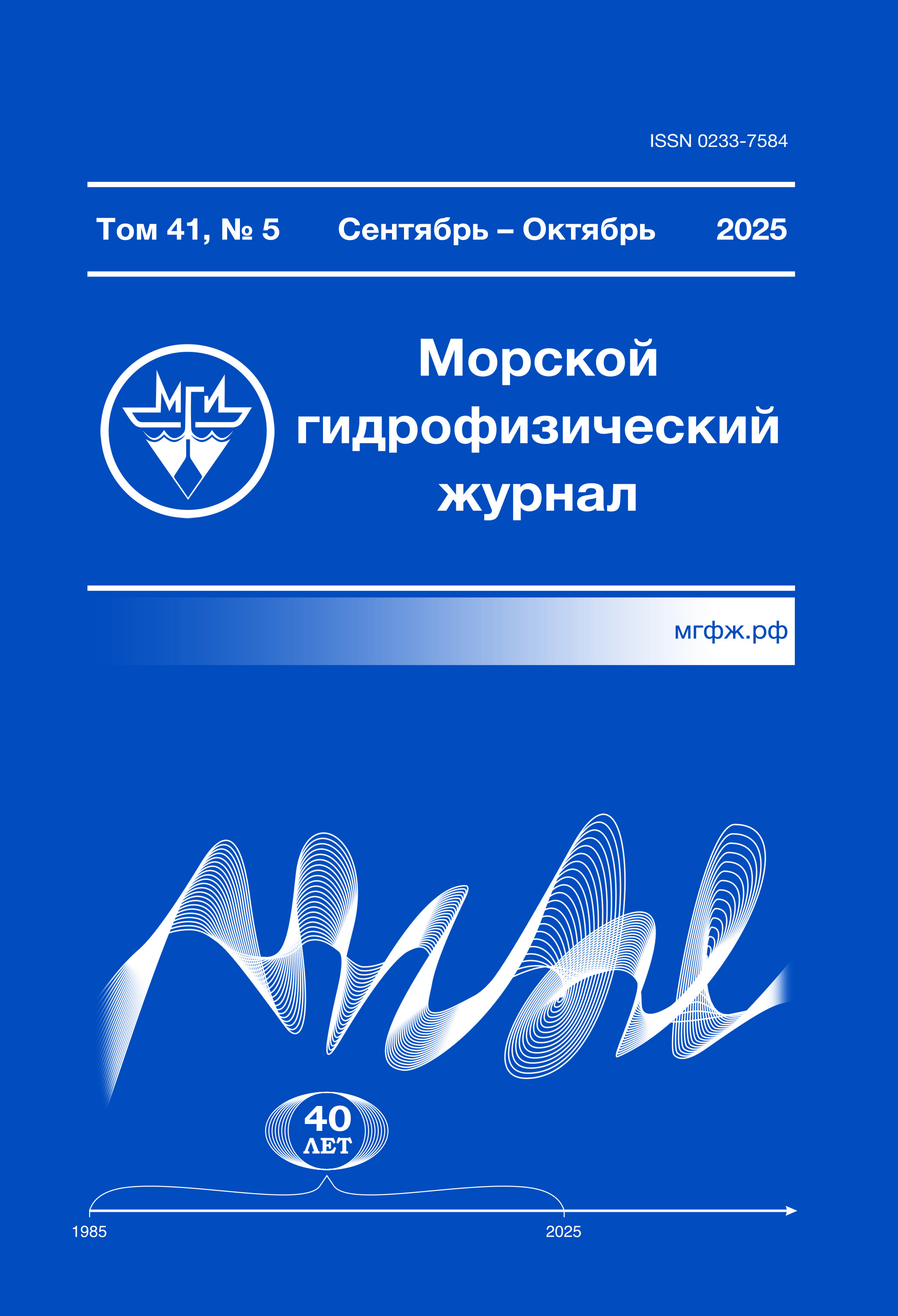Sevastopol', Sevastopol, Russian Federation
Russian Federation
Purpose. The purpose of the study is to assess the effect of incorporating a two-phase ice structure into a thermodynamic model upon its mechanical and thermophysical features. Methods and Results. The vertical structure of thermophysical and physical-mechanical characteristics of sea ice is studied using the model in which freshwater ice and brine (solid and liquid phases) are in thermodynamic equilibrium. Mathematical description of the heat transfer process is presented by a nonlinear one-dimensional equation of heat diffusion, with no regard to penetrating radiation and brine migration within the ice thickness. Salinity distribution was modeled both by the empirical dependence of ice integral salinity on its thickness and by the polynomial reproducing the C-shaped vertical salinity profile characteristic of thin growing ice. The numerical experiments were performed to reproduce the crystallization of brackish seawater under various changes in surface air temperature, both with and without regard to the presence of a liquid phase in the ice cover. The features of vertical distribution of thermophysical and physical-mechanical properties of sea ice during the period of its growth were re-vealed. Conclusions. It is shown that the thermal conductivity coefficients of the ice upper layer obtained with no regard to the two-phase structure are significantly lower, especially at the beginning of ice formation. The permeability of ice cover formed of seawater with different initial salinity and air temperature is assessed. The time periods when the upper ice layer of a given thickness becomes completely imperme-able to brine migration are defined.
sea ice, sea ice growth, salinity, two-phase zone
1. Hunke E. C., Hebert D. A., Lecomte O. Level-ice melt ponds in the Los Alamos sea ice model, CICE // Ocean Modelling. 2013. Vol. 71. P. 26–42. https://doi.org/10.1016/j.ocemod.2012.11.008
2. Turner A. K., Hunke E. C., Bitz C. M. Two modes of sea-ice gravity drainage: A parameteriza-tion for large-scale modeling // Journal of Geophysical Research: Oceans. 2013. Vol. 118, iss. 5. P. 2279–2294. https://doi.org/10.1002/jgrc.20171
3. Turner A. K., Hunke E. C. Impacts of a mushy-layer thermodynamic approach in global sea-ice simulations using the CICE sea-ice model // Journal of Geophysical Research: Oceans. 2015. Vol. 120, iss. 2. P. 1253–1275. https://doi.org/10.1002/2014JC010358
4. Simulating the mass balance and salinity of Arctic and Antarctic sea ice. 1. Model description and validation / M. Vancoppenolle [et al.] // Ocean Modelling. 2009. Vol. 27, iss. 1–2. P. 33–53. https://doi.org/10.1016/j.ocemod.2008.10.005
5. Vancoppenolle M., Fichefet T., Goosse H. Simulating the mass balance and salinity of Arctic and Antarctic sea ice. 2. Importance of sea ice salinity variations // Ocean Modelling. 2009. Vol. 27, iss. 1–2. P. 54–69. https://doi.org/10.1016/j.ocemod.2008.11.003
6. The multiphase physics of sea ice: a review for model developers / E. C. Hunke [et al.] // The Cryosphere. 2011. Vol. 5, iss. 4. P. 989–1009. https://doi.org/10.5194/tc-5-989-2011
7. Zav'yalov D. D., Solomaha T. A. Vliyanie diskretizacii termodinamicheskoy modeli na vosproizvedenie evolyucii tolschiny l'da v Azovskom more // Meteorologiya i gidrolo-giya. 2021. № 7. C. 79–89. EDN GTSNDM. https://doi.org/10.52002/0130-2906-2021-7-79-89
8. Zav'yalov D. D., Solomaha T. A. Osobennosti parametrizacii turbulentnogo vzaimodey-stviya s podstilayuschey poverhnost'yu v regional'noy termodinamicheskoy modeli mor-skogo l'da // Morskoy gidrofizicheskiy zhurnal. 2023. T. 39, № 4. C. 421–434. EDN KONRCG.
9. Untersteiner N. On the mass and heat budget of Arctic sea ice // Archiv für Meteorologie, Geo-physik und Bioklimatologie, Serie A. 1961. Vol. 12, iss. 2. P. 151–182. https://doi.org/10.1007/BF02247491
10. Andreev O. M., Ivanov B. V. Parametrizaciya vertikal'nogo raspredeleniya solenosti odnoletnego morskogo l'da dlya zadach termodinamicheskogo modelirovaniya v Arktike // Problemy Arktiki i Antarktiki. 2007. T. 75, № 1. C. 99–105.
11. Petrich C., Eicken H. Growth, Structure and Properties of Sea Ice // Sea Ice / Ed. D. N. Thom-as, G. S. Dieckmann. United Kingdom : Wiley-Blackwell, 2009. P. 23–77. https://doi.org/10.1002/9781444317145.ch2
12. Ryvlin A. Ya. Metod prognozirovaniya predela prochnosti ledyanogo pokrova na izgib // Problemy Arktiki i Antarktiki. 1974. T. 45. C. 79–86.
13. Notz D., Worster M. G. In situ measurements of the evolution of young sea ice // Journal of Geophysical Research: Oceans. 2008. Vol. 113, iss. C3. C03001. https://doi.org/10.1029/2007JC004333
14. Rees Jones D. W., Worster M. G. A physically based parameterization of gravity drainage for sea-ice modeling // Journal of Geophysical Research: Oceans. 2014. Vol. 119, iss. 9. R. 5599–5621. https://doi.org/10.1002/2013JC009296


















